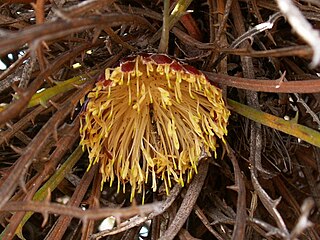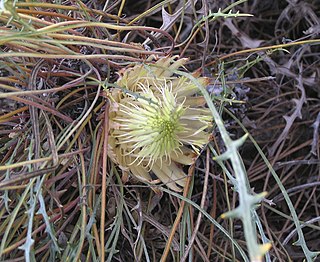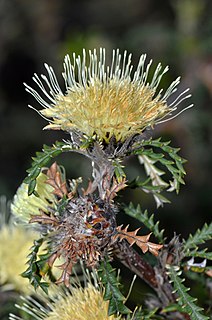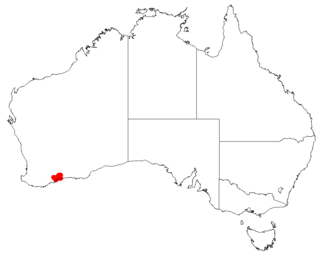
Banksia incana, commonly known as the hoary banksia, is a species of shrub that is endemic to the south-west of Western Australia. It has hairy stems, narrow linear leaves, heads of bright yellow flowers and later, up to thirty-six follicles covered with greyish hairs in each head.

Banksia laevigata, commonly known as the tennis ball banksia, is a species of shrub that is endemic to Western Australia. It has serrated, broadly linear to narrow wedge-shaped leaves, yellow or yellowish green flowers, depending on subspecies, and linear to elliptic follicles with a slightly wrinkled surface.

Banksia armata, commonly known as prickly dryandra, is a species of often sprawling shrub that is endemic to Western Australia. It has deeply serrated leaves with sharply pointed lobes and spikes of about 45 to 70 yellow flowers.

Banksia cirsioides is a species of shrub that is endemic to Western Australia. It has pinnatisect leaves with between six and ten lobes on each side and hairy heads of yellow and pink flowers.

Banksia comosa, commonly known as Wongan dryandra, is a species of shrub that is endemic to Western Australia. It has linear leaves with widely spaced, sharply pointed serrations, heads of yellow flowers and glabrous fruit.

Banksia rufa is a species of prostrate shrub that is endemic to the south-west of Western Australia. It has broadly linear, pinnatifid or pinnatipartite leaves with between five and twenty lobes on each side, yellow, orange or brownish flowers in heads of forty or more, and glabrous, egg-shaped follicles.

Banksia fraseri is a species of shrub that is endemic to Western Australia. It has hairy stems, broadly linear pinnatisect leaves with between four and eighteen sharply-pointed lobes on each side, between eighty and one hundred pink to cream-coloured flowers and wege-shaped follicles.

Banksia hewardiana is a species of openly branched shrub that is endemic to Western Australia. It has linear, serrated leaves with sharply pointed teeth, head of up to sixty lemon-yellow flowers and oblong follicles.

Banksia kippistiana is a species of shrub that is endemic to Western Australia. It has linear, pinnatifid leaves with ten to twenty lobes on each side, heads of up to eighty yellow and cream-coloured flowers, and elliptical follicles.

Banksia bella, commonly known as the Wongan dryandra, is a species of dense shrub that is endemic to a restricted area of Western Australia. It has narrow, deeply serrated leaves covered with white hairs on the lower surface, heads of yellow flowers and few follicles in the fruiting head.

Banksia heliantha, commonly known as oak-leaved dryandra, is a species of shrub that is endemic to Western Australia. It has hairy stems, serrated, egg-shaped to wedge-shaped leaves, golden yellow flowers and partly woolly follicles.

Banksia splendida, commonly known as shaggy dryandra, is a species of shrub that is endemic to the southwest of Western Australia. It has sharply-pointed linear leaves that are woolly on the lower surface, cream-coloured and maroon or yellow flowers in heads of between 65 and 115, and later up to eight egg-shaped follicles in each head.

Banksia armata var. armata is a variety of shrub that is endemic to Western Australia. It differs from the other variety in having a lignotuber, narrower leaves with more side lobes and shorter flowers. It is also usually a shorter plant.

Grevillea armigera, also known as prickly toothbrushes or thorny grevillea, is a species of flowering plant in the family Proteaceae and is endemic to the south-west of Western Australia. It is an erect to spreading shrub with deeply-lobed leaves, the lobes linear and sharply pointed, and grey, green or pale yellow flowers with black to maroon styles.
Carl Meissner's taxonomic arrangement of Dryandra, now Banksia ser. Dryandra, was published in 1856 as part of his chapter on the Proteaceae in A. P. de Candolle's Prodromus systematis naturalis regni vegetabilis. It replaced the 1830 arrangement of Robert Brown, and remained current until superseded by the 1870 arrangement of George Bentham.

Grevillea asparagoides is a species of flowering plant in the family Proteaceae and is endemic to the south-west of Western Australia. It is dense, prickly shrub with deeply divided leaves, the end lobes linear and sharply pointed, and pink to reddish flowers with red styles.
Persoonia rudis is a species of flowering plant in the family Proteaceae and is endemic to the south-west of Western Australia. It is an erect shrub with hairy young branchlets, linear leaves, and yellow flowers borne in groups of five to thirty on a rachis 3–100 mm (0.12–3.94 in) that continues to grow after flowering.

Persoonia dillwynioides, commonly known as Fitzgerald persoonia, is a species of flowering plant in the family Proteaceae and is endemic to a restricted area in the south-west of Western Australia. It is an erect, spreading shrub with smooth bark, linear leaves and bright yellow flowers borne singly or in groups of up to four along a rachis up to 3 mm (0.12 in) long.
Persoonia hakeiformis is a species of flowering plant in the family Proteaceae and is endemic to the south-west of Western Australia. It is an erect or spreading to low-lying shrub with mostly smooth bark, linear leaves and bright yellow flowers borne in groups of up to sixty along a rachis up to 100 mm (3.9 in) long.
Isopogon villosus is a species of flowering plant in the family Proteaceae and is endemic to southwestern Western Australia. It is a tufted shrub with cylindrical leaves with twenty-five to thirty-two widely diverging lobes, and oval heads of cream-coloured to yellow flowers.

















